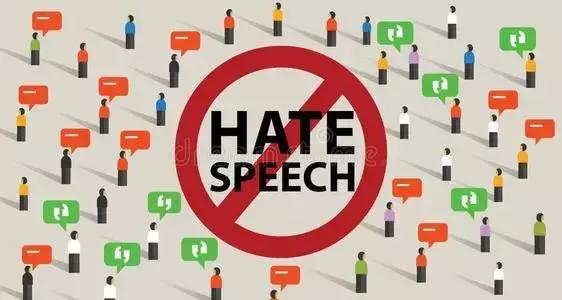
Introduce
With the development of social platforms, from individual harassment to group insults, from anonymous attacks to human flesh searches, hate speech has long broken through the boundaries of text and is infiltrating into real society through digital space. Whether due to personal preferences, racial beliefs, etc., more and more people are suffering from cyber violence, the severity of which even threatens their lives. This article explores the definition of hate speech and the harm it causes online, as well as the challenges and countermeasures of digital regulation of hate speech through some tragedies caused by online hatred.
Withered pink

Figure 1: Zheng Linghua’s post on the social platform (Source)
In July 2022, a young Chinese girl Linghua Zheng shared a proud moment in her life with sincere joy and deep affection for her family. She shared photos of herself being admitted to graduate school and taking photos with her sick grandfather on social platforms, but was attacked and insulted by countless strangers, with malicious labels ranging from “showmanship” to “improper” to “bar girl”. They didn’t know her, but accused her of being unworthy of being a teacher, speculating that she was making a video show to deliberately show her “filial piety”, and some even suspected that she had an improper relationship with her grandfather… and all this was just because she dyed her hair pink.
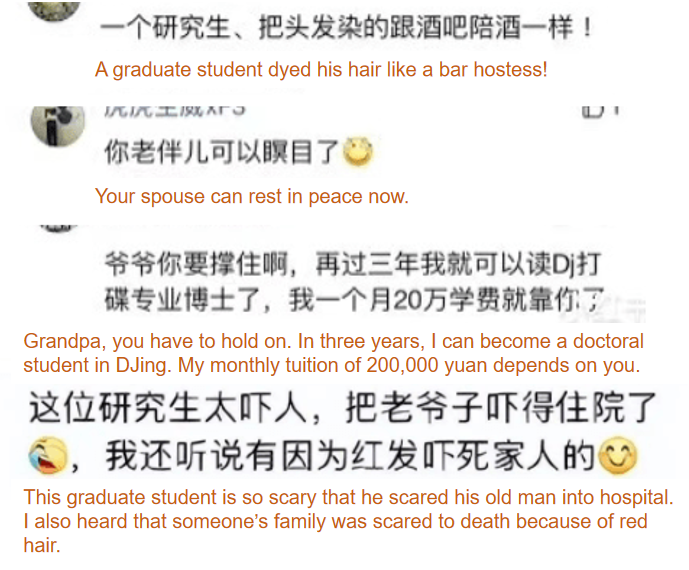
Figure 2: Netizens’ malicious comments on Ms. Zheng’s pink hair (Source)
The originally warm sharing was distorted into the crime of “sensationalism”.
During this period, Zheng Linghua actively defended her rights, reporting and suing those unscrupulous marketing accounts and netizens who insulted her. Her rights protection action has made considerable progress: most of the infringing users on the platform have stopped the infringement, and some who scolded her have also apologized.
But since then, more people have abused her, saying that she is fragile and hype.
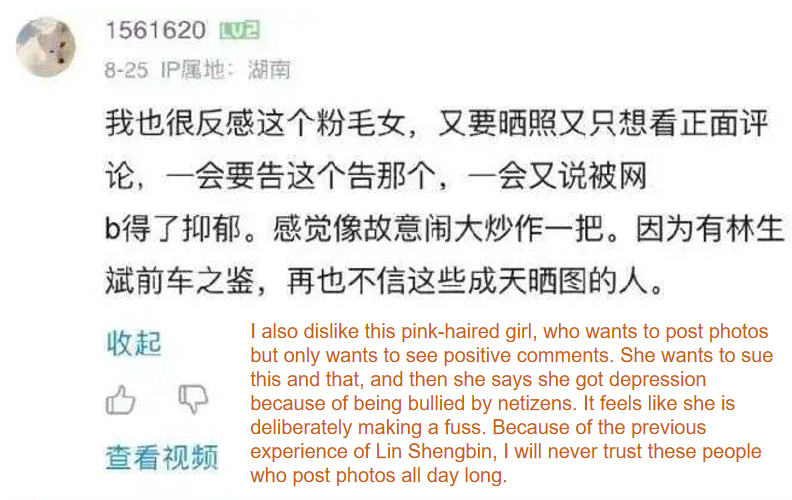
Figure 3: Netizens accuse Ms. Zheng of being fragile (Source)
Eventually, under the continuous online harassment and mental torture, Zheng Linghua suffered from severe depression and committed suicide six months later after fighting the disease in vain. She once said before her death: “I just want my grandfather to be proud of me.” Such a simple wish was torn apart in malice.
This tragedy reveals how hate speech can easily destroy the goodwill sharing of an ordinary girl with the help of stereotypes and online violence. Pink hair has become a label, kindness has been interpreted maliciously, and the Internet has become a hotbed of attack and humiliation. The malice that is casually vented behind the keyboard has evolved into irreparable harm in reality. This is not only a personal tragedy, but also a network hazard that the society should reflect on together. Why can malice spread so easily behind the keyboard?
What is hate speech?
Social media should be a platform for people to express, communicate and support each other. However, under the abuse of some people, it has also become a hotbed for hate speech (Castaño-Pulgarín et al., 2021). Chetty and Alathur (2018) pointed out that hate speech is an aggressive communication mechanism. Such speech often uses deep-rooted stereotypes in society to spread and consolidate certain hatred. For example, in the pink-haired girl incident, people made malicious comments about Zheng Mou’s pink hair, such as “a bar girl” and “unworthy of being a teacher”, which actually spread prejudice and hatred against the hair dyeing group.
A similar incident is the suicide of Zhou Peng, a 26-year-old Chinese photographer, because of bullying for being “sissy”. Although he never deliberately imitated girls, he was ridiculed and bullied because of his delicate appearance and gentle personality, which did not conform to the traditional male image.
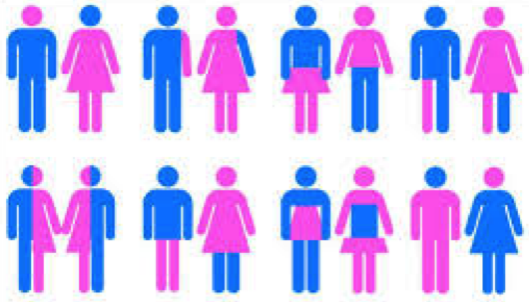
Figure 4: (Source)
The emergence of hate speech is not accidental, but rooted in the instinctive tendency of human beings to identify with groups. People tend to divide others into “us” and “them”, give positive evaluations to the inner group, and are prone to hostility and exclusion towards the outer group (Kopytowska, 2017). The outer group is regarded as an unwelcome existence and a reasonable object of hostility (Flew, 2021). Kopytowska (2017) also pointed out that this “othering” process is further amplified in cyberspace, stereotypes and emotional catharsis spread rapidly, and eventually evolved into invisible violence. Hate speech not only hurts individuals, but also tears apart the social trust structure.
The spread of digital media and the so-called “freedom of speech” have further contributed to the breeding of hate speech (Chetty & Alathur, 2018).
The kidnapping of freedom hiding behind “free speech”
Many people on the Internet use “freedom of speech” as a shield, and recklessly criticize others in the comment area, using biased or even malicious language to hurt strangers. They seem to be “expressing their opinions”, but in fact, they are interfering with other people’s life choices and imposing their own values on others – not dyeing hair is worthy of graduate school, not wearing short skirts is considered self-love, and hard work is a virtue… They hold high the name of “freedom”, but in fact they kill true diversity and tolerance.
How ironic, talking about freedom of speech, but wantonly using language to kidnap others’ freedom – freedom of dress, freedom of orientation, freedom of consumption…
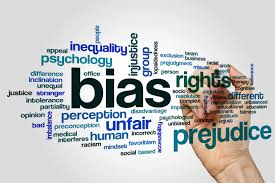
Figure 5: (Source)
Freedom of speech is never a pass to hurt others. The boundaries of freedom stop at the dignity and rights of others. The core of freedom of speech is to protect individuals’ exploration of truth, self-realization, free expression and communication, so as to achieve a balance and progress between social stability and change (Balkin, 2004). What we want to defend is everyone’s right to express, to be different, and to choose, rather than encouraging a violent culture of using language to humiliate, ridicule, and judge. Don’t let “freedom” become a tool to oppress others. Really mature freedom of speech should include respect for the freedom of others and responsibility for public space.
The Internet exacerbates the dangers of hate speech
The terrible thing about online hate speech, in addition to “freedom of speech”, is that it is “follow the trend without responsibility”. Many people may just follow the trend and click on the “laughing” expression, but they don’t know that every light comment will become the straw that breaks the camel’s back. And the law and the platform are often unable to stop these injuries in time, making the victims gradually isolated and collapsed in the midst of the malice.
In cyberspace, the anonymity and irresponsibility of speech make “follow the trend” a common phenomenon (esafety, 2025). Kim (2023) pointed out that anonymity provides perpetrators with an opportunity to separate online behavior from their real identity, thereby evading responsibility and getting rid of the constraints of social norms, which may make them more aggressive than in reality. Because users do not need to bear the real consequences, they can quickly forward, comment, and abuse under the influence of emotions.
Individuals feel recognition and power in the group, but ignore that their words may be destroying another real life. The rapid spread of the Internet amplifies this irresponsible expression, making malice more diffusive and leaving victims with almost nowhere to escape.

Figure 6: (Source)
Hate speech on the Internet has made being different a target of public criticism. It amplifies prejudice, incites hostility, creates opposition between “us” and “them”, and turns the originally neutral public opinion field into a battlefield for emotional venting. For individuals, such speech may cause serious psychological trauma, self-denial, and even lead to extreme behaviors such as depression, self-harm or suicide; for society, it promotes collective violence, intensifies social contradictions, and weakens the inclusiveness and trust of public space.
Under the promotion of algorithms and the protection of anonymity, malicious speech is more easily spread and amplified, forming a “cyber violence cycle”, leaving victims nowhere to escape and making the entire public discussion environment hostile and fearful.
22-year-old Kimura became the target of cyberbullying on social media for participating in the show “Terrace House: Tokyo 2019-2020”. She lost her cool because a male actor in the show mixed his expensive wrestling suit with his clothes and caused the wrestling suit to shrink. In fact, this is not a big deal. After all, everyone has been angry at others. But under the fermentation of online media, Kimura received about 300 defamatory Twitter comments from about 200 accounts, which caused her to collapse and finally commit suicide.
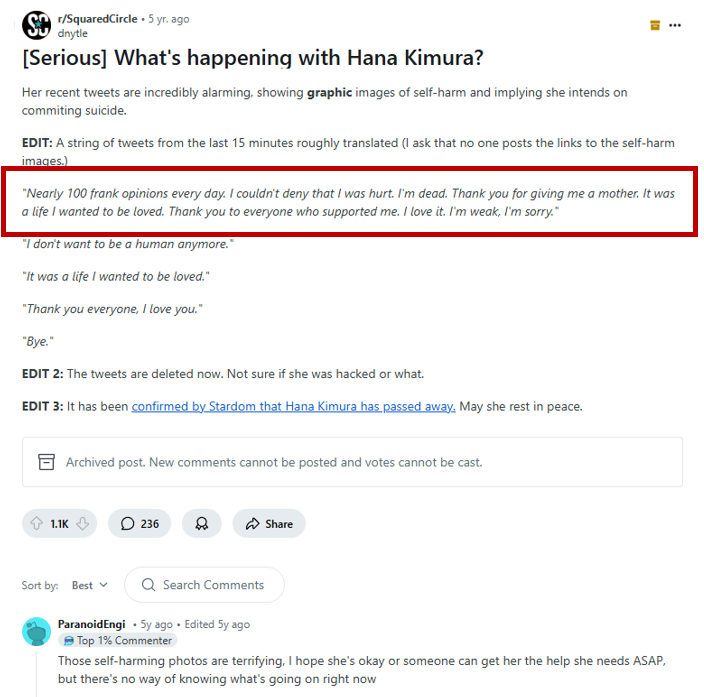
Figure 7:Tweets by Hana Kimura (Source)
We need to realize that words are never harmless. In the Internet age, the bottom line of civilization is not only in reality, but also between keyboards. Everyone who uses the Internet should be responsible for their words.
The challenge of regulating online hate speech
Although more and more platforms and laws are beginning to intervene in the management of hate speech, there are still many challenges in the implementation process.
The definition of hate speech is vague
The boundaries between hate speech and offensive speech, political expression, and satire are blurred, which can easily lead to misjudgment or mistaken deletion.
Persily (2020) pointed out that the definition of hate speech is extremely complex, especially in the context of the Internet, where its expression is constantly evolving, and the language may be obscure, strategic, or even use code words or symbols for hidden expressions. This makes the traditional “intuitive identification” method difficult to work.
He believes that although insults and defamation are easier to identify, many harmful languages are ignored because of their subtlety and professionalism. The definition of hate speech swings from broad (derogation of specific groups) to narrow (dangerous speech that incites violence), reflecting the tension between regulation and freedom. Algorithms have difficulty identifying context, metaphors, or suggestive speech, resulting in low efficiency and accuracy in review.
Therefore, if the platform wants to perfectly judge whether it is hate speech or just offensive language, it is necessary to further build processes and review methods for identifying triggers and forms of hate speech (Sinpeng et al., 2021).
The algorithmic mechanism of digital platforms
Hate speech can easily ferment and spread on digital platforms where information spreads at a very fast speed. In order to maximize traffic and commercial interests, platforms may allow highly interactive, controversial or even offensive content to spread, which will lead to more exposure of hate speech in algorithm recommendations.

At the same time, users can easily switch accounts between multiple platforms or use different identities to spread hate speech, thereby circumventing the ban or monitoring of a single platform. This cross-platform dissemination behavior has exacerbated the fragmentation of supervision and the lag in law enforcement, making hate speech more difficult to track and control.
Figure 8: How to switch between Cloze accounts (Source)
Differences in regulation among countries and emphasis on freedom of speech
Different countries have adopted different legal approaches to deal with the tension between hate speech and freedom of speech. Canada emphasizes the importance of public interest and truthful statements, while the UK has stricter restrictions on threatening speech. Poland and the UAE clearly stipulate that hate speech will be punished, including imprisonment and fines. In the United States, due to the extremely high protection of freedom of speech in the First Amendment of the Constitution, hate speech is vaguely defined in law, and speech regulation relies more on social mechanisms and institutional norms. (Chetty & Alathur, 2018). And coincidentally, these countries often respect “freedom of speech” very much, regardless of whether they have strict supervision of hate speech.
These differences and similarities show that how to define and regulate hate speech is still an issue that countries are constantly balancing between laws, culture and values.
Strategies
Concerned that such harmful speech could incite violence and promote extremism, governments around the world are passing regulations and forcing social media companies to implement policies to stop the spread of online hate speech.
But the fact is that the implementation of these laws and policies will always be restricted by the freedom of speech. We should reduce the emergence of hate speech from the inside out. It is urgent to improve the digital literacy of netizens, cultivate the public’s ability to identify malicious speech, and advocate rational expression and respect for differences. This is the root cause of online hatred. But this cannot be accomplished overnight. Therefore, at this stage, to curb the spread of hate speech, it is still necessary for enterprises, civil society and government actors to participate in various Internet governance arrangements (Sinpeng et al., 2021)
In addition, each public communication platform should set up a review control team to promptly detect hate speech against individuals or even groups, control it before it ferments to an uncontrollable level, and provide psychological assistance and legal support to victims to reduce the secondary harm caused by online violence.
Conclusion
We live in an era of information explosion and high freedom of expression on the Internet, but this freedom should not come at the cost of hurting others. The Internet is not a garbage dump for emotions, nor is it a safe haven for anonymous venting. We must face up to the fact that cyberspace is not a “free zone” that is out of ethics and law, but a public domain that urgently needs regulation and reflection. The key to reflection is: Have we inadvertently contributed to this culture? Have we become indifferent accomplices with the attitude of “eating melons” and “watching”?
Real change comes not only from policies and platforms, but also from every user’s self-reflection before forwarding, commenting, and pressing the “send” button. Facing the keyboard, each of us should ask ourselves: Am I expressing, or hurting?
References
Castaño-Pulgarín, S. A., Suárez-Betancur, N., Vega, L. M. T., & López, H. M. H. (2021). Internet, social media and online hate speech. Systematic review. Aggression and Violent Behavior, 58, 101608-. https://doi.org/10.1016/j.avb.2021.101608
Flew, T. (2021). Regulating Platforms. Polity Press.
Chetty, N., & Alathur, S. (2018). Hate speech review in the context of online social networks. Aggression and Violent Behavior, 40, 108–118. https://doi.org/10.1016/j.avb.2018.05.003
Kopytowska, M., & Baider, F. (2017). From stereotypes and prejudice to verbal and physical violence: Hate speech in context. Lodz Papers in Pragmatics, 13(2), 133–152. https://doi.org/10.1515/lpp-2017-0008
Balkin, J. M. (2004). Digital speech and democratic culture: A theory of freedom of expression for the information society. New York University Law Review (1950), 79(1), 1-.https://sydney.primo.exlibrisgroup.com/permalink/61USYD_INST/2rsddf/cdi_proquest_journals_207652870
Kim, M., Ellithorpe, M., & Burt, S. A. (2023). Anonymity and its role in digital aggression: A systematic review. Aggression and Violent Behavior, 72, 101856-. https://doi.org/10.1016/j.avb.2023.101856
Persily, N., & Tucker, J. A. (Joshua A. (Eds.). (2020). Social media and democracy : the state of the field, prospects for reform. Cambridge University Press.https://sydney.primo.exlibrisgroup.com/permalink/61USYD_INST/1c0ug48/alma991032504445505106
Sinpeng, A., Martin, F., Gelber, K., & Shields, K. (2021, July 5). Facebook: Regulating hate speech in the Asia Pacific. Final Report to Facebook under the auspices of its Content Policy Research on Social Media Platforms Award. Dept of Media and Communication, University of Sydney and School of Political Science and International Studies, University of Queensland. https://r2pasiapacific.org/files/7099/2021_Facebook_hate_speech_Asia_report.pdfLinks to an external site.

Be the first to comment